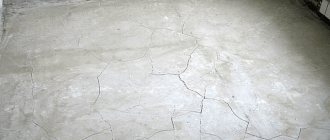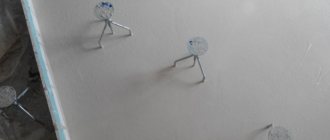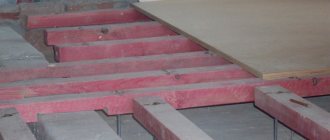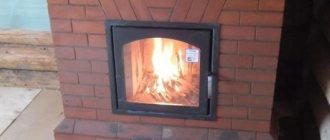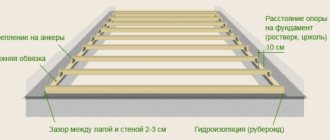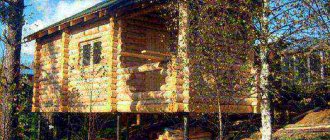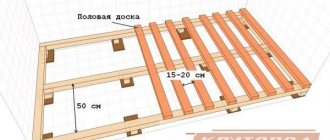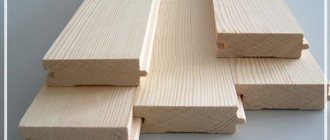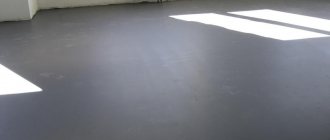Relatively recently, to compensate for thermal expansion when installing screeds, builders used various available materials. But they all had certain drawbacks. The art of construction, as we know, does not tolerate mistakes; all technologies must be carefully verified. Therefore, based on the results of operation and observations, new products are constantly being developed, which undergo repeated experimental testing.
Today, damper tape for screed is used as a compensator for linear deformation of concrete.
For what purpose and where is it used?
This is a relatively new material, which is consumable and consists of tapes of different thicknesses and heights, made of elastic materials that easily compress under load and restore their shape in its absence. The raw material for production is foamed polyethylene, in closed cells of which there is air.
To understand how the tape works, you can do a simple experiment. If you squeeze it with your fingers, the air bubbles are flattened, the material becomes thinner, but returns to its original size when the pressure is released.
After which it becomes clear why the damper tape is needed. Its main function in the structure of a concrete floor is to compensate for the linear expansion of the screed, preventing its deformation in case of hard contact with the walls. As the slab expands, it presses not on the wall, but on an elastic gasket installed between them and filling the gap between the contacting planes.
Shock-absorbing tape when installing a floating screed Source i2.wp.com
However, the use of such a layer makes sense only if the screed is floating, that is, not connected to the base and mounted on waterproofing (waterproof film) or thermal insulation (insulation boards). If it is laid on a stable base and does not have a heating system, the damper will be useless.
But there are other tasks that can be achieved using this material. When deciding whether a damper tape is needed for a floor screed, you should also remember these:
- Compensation for periodic expansion of heated screeds from a heated floor system.
When the system is running, the plate expands in proportion to the heating force, and when it is turned off, it contracts. Periodically occurring pressure on the walls can ruin the external finish and cause stress and deformation in the structure itself.
On a note! When installing heated floors along external walls, it is better to install strips of insulation. This will not only compensate for temperature changes, but also reduce heat loss.
Diagram of a heated water floor Source pol-inform.ru
- Creating a gap between rooms with different thermal circuits.
In adjacent rooms, different temperatures of the heated floor are often set. Accordingly, it is necessary to arrange a thermal gap between them.
Such a compensator is mounted in a doorway Source eurosantehnik.ru
- Reduced vibration noise.
Another important point why damper tape is needed when screeding is to improve sound insulation between rooms. It dampens vibration and impact noise and prevents its transmission through supporting structures. This is especially true in high-rise buildings, townhouses and country houses with several apartments.
On a note! There is a special type of damper tapes - vibration damping tapes. They are made from rubber, caoutchouc, and other materials and are glued to metal profiles, which are the basis of the frame for interior partitions and wall cladding.
- Reduced cracking when fresh screed matures.
During the drying process, concrete loses moisture and “breaks” with the appearance of cracks. This problem is solved by reinforcing the screed and isolating it from the walls with an elastic gasket. It is laid around the perimeter, as well as in the body of the screed, if its linear dimensions on any side exceed 6-8 meters or the total area of the screed is more than 20 sq.m.
Separating the screed with a compression tape reduces the formation of shrinkage cracks Source chudopol.ru
- Construction of a technological gap between screed sectors poured at time intervals.
When a fresh screed comes into direct contact with a previously poured screed that has already gained strength, uncontrolled stresses arise that affect the strength of the coating. They are compensated by laying a buffer layer between adjacent sectors.
Summarizing the above, such a gasket must be done in the case of a floating screed or heated concrete screed. If we answer the question whether a damper tape is needed when pouring a self-leveling floor, then it will be positive only if there is a thick layer of leveling mixture or when it is installed on top of a heated floor. Simple thin-layer coatings up to 10 mm high do not need an edge around the perimeter of the walls.
When installing thin-layer self-leveling coatings, a buffer layer is not needed Source i.ytimg.com
All other cases are considered individually, the choice remains at the discretion of the home owner.
Advantages
The advantages of this product compared to other materials are related to the technical and operational characteristics of foamed polyethylene:
- excellent sound and heat insulation qualities, vibration absorption;
- high levels of moisture resistance and moisture resistance - characteristics that are of particular importance for floors;
- absence of linear deformation due to changes in temperature and moisture;
- plasticity: foamed polyethylene is able to compress and recover without tearing, so concrete can expand without negative consequences;
- complete tightness and strength;
- no rotting, biological stability;
- durability;
- easy installation.
In addition, this material is distinguished by a high degree of environmental friendliness, so it is absolutely safe for use in residential areas.
What are damper tapes?
Kinds
The material is distinguished according to several characteristics:
- According to the structure of polyethylene – cross-linked and non-cross-linked.
Sewn material is more expensive, but of better quality - it is more elastic and reliable. When uncrosslinked, the cell walls tear under heavy load.
- Depending on the installation location, the tape can be edge or intercircuit.
Edge screeds are mounted along the edges of the screed to be poured along the walls and have a flat or L-shaped shape. Intercircuit tapes are designed for making expansion joints in large-area screeds and between adjacent heating circuits. They are shaped like an inverted T, making it easy to secure the strips to the base without side support.
- According to the installation method.
The simplest type of tape is ordinary flat strips, which are simply pressed against the walls with mortar or pre-attached with improvised means. Strips with adhesive applied to the reverse side simplify the task of attaching the damper tape to the wall. The sticky layer of self-adhesive is protected by paper, which can be easily removed before installation.
Installation of tape with adhesive strip Source pol-exp.com
Both standard and self-adhesive strips can have a “skirt” - this is an outlet made of non-foamed polyethylene on one side. During installation, the tape with the “skirt” straightened out on the floor takes the shape of an inverted letter G. The resulting angle prevents the solution from leaking into the junction of the floor and walls, which increases the functionality of the buffer.
- By the presence of cuts.
Such products are often provided with small cuts along the entire length at several levels. They make it easier to remove excess material protruding above the surface of the finished coating.
The cuts allow you to tear off excess at the desired height Source pol-exp.com
Video description
What can happen if you do not leave gaps along the walls when laying laminate, watch in the video:
The excess part of the strip protruding above the plane of the final coating is cut to its level or left behind the baseboard.
The thickness of the buffer layer is selected in accordance with the linear dimensions of the screed. When installing it in standard residential premises and garages, shock absorbers with a thickness of 6-10 mm are usually used.
The material is sold in rolls of various lengths from 10 to 150 meters. You can easily calculate the length you need by adding up the perimeter of all the walls and the length of the expansion joints in rooms with screed.
To get a rough idea of the price order, check out this table:
Parameters of damper tapes from different manufacturers Source i.ibb.co
How to choose?
Material such as deformation edge tape is sold on the market in large quantities and assortment. Therefore, choosing a tape of the right size is quite simple. The packaging in which it is sold is easy to transport, since the product is very light due to its porosity. Its average cost depends on the manufacturer and is approximately 300-400 rubles per roll.
But the purchase of construction tape is not always successful, and during the process, significant flaws in the product become apparent. Therefore, when choosing this type of product, you need to pay attention to the following factors:
- Integrity of the product and absence of deformation. The tape in the roll should be smooth on all sides, without obvious damage, and there should be no crooked or torn edges. Holes, dents and other defects indicate improper storage of the product, therefore, such a product should not be purchased, otherwise it may negatively affect the quality of construction work.
- External parameters. The canvas must be clean, without visible defects.
- Density. If there are cracks, voids and crevices in the roll, then there is a high probability that the sticky surface is damaged, which means it is unusable and should not be attached.
Choosing the optimal model and size of the damper tape can significantly reduce the cost estimate, facilitate and speed up the repair process, and ensure the reliability and integrity of the screed. This directly depends on the thickness of the layer and the characteristics of the room - heat loss, humidity and degree of temperature difference, as well as the area of the room.
The selection of edge strip thickness depends on the application:
- The walls need a thickness of about 1 cm.
- To fill the dividing seams, you can take a thinner one, preferably a T-shaped one.
The height of the buffer is selected so that it is 2-3 cm higher than the layer of frozen mortar. The length of the roll depends on the perimeter of the room. It should cover the entire perimeter, and the overlap at the joint should be 5 cm.
Installation features
The developer may have a question about how to attach the damper tape and when to do it. Installation is carried out before pouring the screed, but after installing the waterproofing. As a rule, film and any other waterproofing on the sides is lifted and placed on the walls, in which case the buffer tape is installed on top of it.
The installation method depends on the type of product. If it has an adhesive layer, everything is simple: place the roll with the sticky side to the wall and, gradually unrolling it and removing the protective layer, glue the strip to the base, slightly pulling it so as not to falsify. If there is a film release (“skirt”), it is spread on the floor, folded at the corners into a triangle.
Installation of L-shaped tape Source o-builder.ru
Having finished gluing one roll, the second is mounted overlapping, starting the beginning of the second strip 5 cm from the end of the first.
If there is no adhesive strip, you first need to determine the front and back sides. The reverse side is usually smoother and shiny, and it is pressed against the wall.
Rigid fastening is not necessary - the strip can simply be pressed with the solution during its installation. But this is very inconvenient: you have to constantly make sure that it does not fall or bend under the screed, otherwise the whole point of why the damper tape is needed is lost.
Therefore, choose one of the most convenient fixation methods:
- shoot with a stapler, the staples of which easily fit into the wooden base;
- drill the dowel with nails;
- glued with double-sided tape, liquid nails or other adhesive.
Manufacturers
When purchasing compensation material, you must give preference to well-known manufacturers. Most likely it contains:
- the integrity of the canvas will not be compromised;
- the strip will be uniform in width throughout its entire length;
- the protective layer will not lag behind the adhesive;
- The bottom edge will be trimmed evenly.
All this guarantees ease of installation and reliability in operation.
The following manufacturers are considered the best:
- Kermi (Germany). Thickness – 0.8 cm, width – 16 cm, roll – 25 m. Price per roll – ~900 rubles;
- Oventrop (Germany) – self-adhesive with a perforation line. Thickness – 1 cm, width – 12-15 cm. Rolls – from 25 to 50 m. Cost depends on length: 790 – 3075 rubles;
- Uponor (Sweden) – with an adhesive layer, does not contain freon. Thickness – 1 cm, width – 15 cm, roll – 50 m. Cost – ~3500 rubles;
- Energoflor (Russia) – the product is based on polyethylene film, but it meets all the requirements. Thickness – 1 cm, width – 10-15 cm, roll – 11 m, roll price – 450 rubles;
- Tilit Super (Russia) – with a protective apron. Suitable for floating screeds, has a wide temperature range - from -40°C to + 95°C. Thickness – 1 cm, width – 10 cm, roll – 25 m. Roll cost – ~930 rubles;
- Teploflex (Russia) – allows you to cut strips of different widths. Thickness 0.6 – 1.5 cm, width – 1 m, roll length 50 m. Roll price: 1250 – 3650 rubles.
What materials can be replaced
Having figured out what a damper tape is and what it is needed for, many developers are thinking about replacing it with other materials with similar characteristics and saving money. This solution seems especially attractive if, after building a house, there is a lot of unused insulation, laminate underlay, linoleum scraps, etc. left.
In principle, such a replacement is possible, but it will not be complete:
- Foam plastic, after compression under load, is not able to fully restore its shape, as a result of which a gap remains between the vertical surface and the screed.
- Linoleum is generally not a sufficiently elastic material.
- Laminate backing, isolon and penofol, like the original buffer tape, are made from polyethylene foam. But they usually have a lower density and do not have good soundproofing properties.
Penofol and isolon are an affordable analogue of damper tape Source opt-299062.ssl.1c-bitrix-cdn.ru
- Wooden slats, which were previously widely used to make expansion joints, are also poor shock absorbers, and they are also susceptible to destruction from moisture, mold and other external influences.
To get a strip of the required width, it needs to be cut from the roll. This can be done in a variety of ways. The longest way to cut is with scissors. It is much faster and more accurate to cut with a sharp stationery knife on a flat and hard surface, made along a guide. To do this, roll out the roll on the floor or on a board, place a guide rail at a selected distance from the edge and guide it with the tip of a knife along it.
To speed up the process, the material can be folded in several layers.
If you need to cut strips of great length (and for a medium-sized house they may require several hundred meters), it is better to roll the material into a tight roll and cut it with a hacksaw according to the markings.
Possible alternative
During installation and operation, a number of problems and difficulties may arise. In most cases, this is due to insufficient preparation of the premises. To minimize technology violations, it is recommended to familiarize yourself with the advice of specialists.
Often the factory tape may not be available. But to ensure the safety of the coating, its closest analogue should be installed. How to replace the damper tape in this case? The main selection criterion is the material of manufacture. Foamed polyethylene can be replaced with similar polymer compositions.
Most often, penofol is used for this. Its main disadvantage is its small thickness, which cannot provide the required minimum clearance. The multilayer gasket option will be impractical. Over time, the layers may lose their original location, resulting in changes in thickness in certain areas.
Installation of wooden blocks is also not recommended. They have the following disadvantages, which will be reflected in the properties of the entire coating:
- Changes in geometry under the influence of humidity. Fibers have the ability to absorb water;
- Possibility of mold and mildew. This is characteristic of almost all natural materials;
- Short service life due to the factors described above.
The alternative material must have sufficient flexibility, but at the same time return to its original dimensions after the end of exposure to the surface. Installing foam edges will not produce the desired result.
Briefly about the main thing
Now you know what a damper tape for floor screed is, what it is needed for, what it is made from and what functions it performs. Its main purpose is to compensate for the movements of a floating concrete screed or self-leveling floor, and to serve as a shock absorber between them and adjacent surfaces. The material is sold in the form of rolls of different thicknesses and widths, fixed along the bottom of the walls or separates screed sectors with different heating circuits. Mounted using an adhesive layer or mechanical fasteners. You can replace the tape with similar materials cut into strips - isolon, penofol, laminate backing.
Ratings 0
Three solutions for soundproofing the ceiling
Soundproofing the ceiling will make the apartment quieter and relations with neighbors more pleasant. Let's figure out how to do this project independently, quickly and on a budget.
Airborne and impact noise enters the apartment through the ceiling. Airborne noise is music, conversations, barking dogs and children's songs. Stomping, jumping, and hitting balls are impact noises. Soundproofing the ceiling reduces airborne noise levels. But only soundproofing the floor in the apartment above will protect you from impact. It is impossible to control the repairs of your neighbors, so in this article we will give tips on how to reduce the level of airborne noise using ceiling soundproofing.
What kind of ceiling sound insulation is there?
Soundproofing projects vary in effectiveness, thickness, installation complexity and price. A solution for soundproofing the ceiling is chosen at the beginning of the renovation, because this is the first stage of finishing work. The choice depends on your plans for soundproofing walls and floors, your budget and the expected level of noise reduction.
